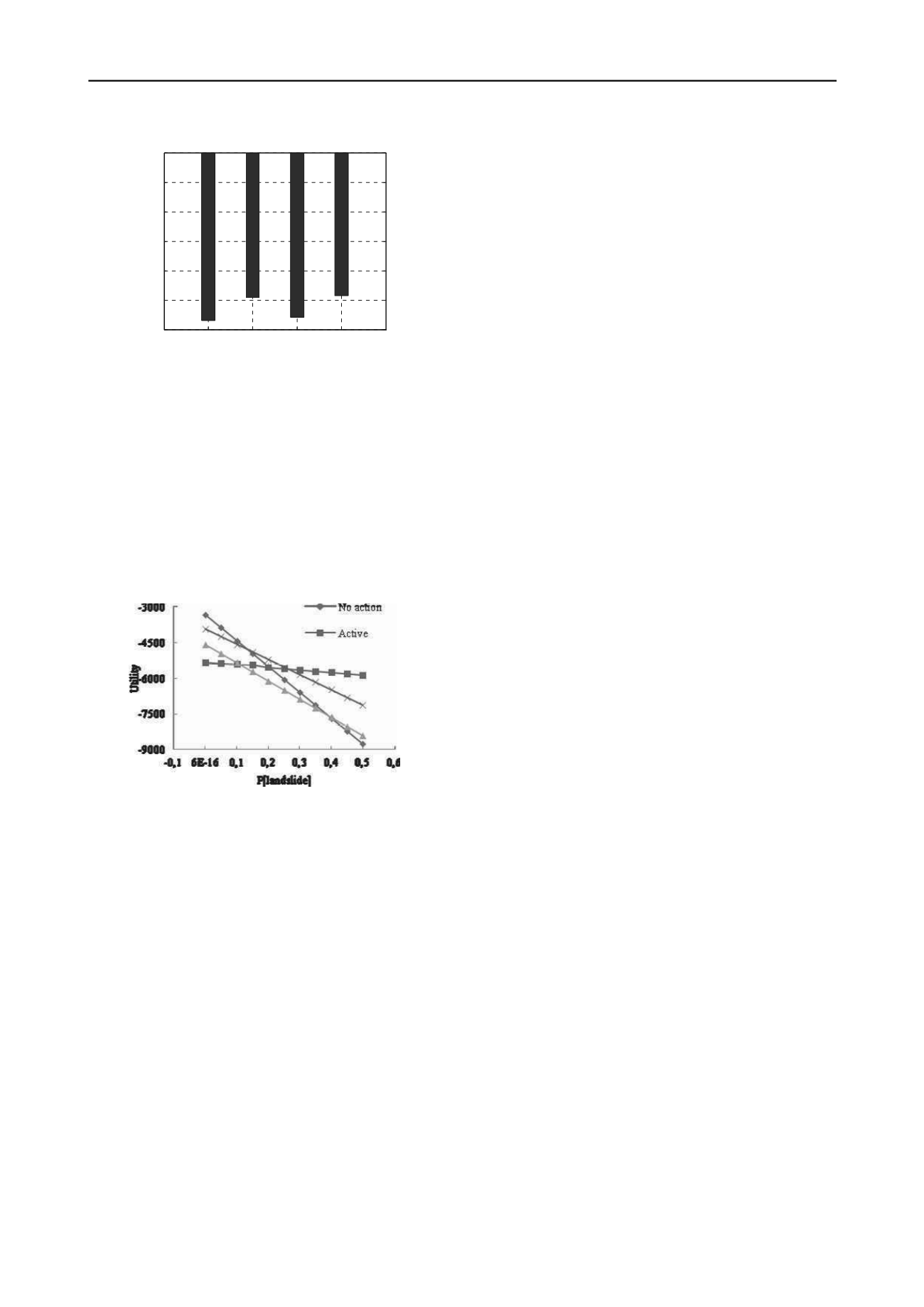
2224
Proceedings of the 18
th
International Conference on Soil Mechanics and Geotechnical Engineering, Paris 2013
Passive No action Active Warning system
-6000
-5000
-4000
-3000
-2000
-1000
0
Mitigation measures
Expected loss
Fig. 6 Comparison of results for Passive countermeasure, No action, Ac-
tive countermeasure, and Warning system.
This result is based on many parameters that can vary, for in-
stance, the costs; the probability of slope failure or the reliabil-
ity of the warning system. Therefore, sensitivity analyses were
conducted to assess the effects of these variations on the results.
Fig. 7 investigates the effect of changing the probability of
landslide occurrence against different measures. As expected,
for very low failure probabilities, no action is preferred; other-
wise a warning system is the best choice, except for very high
probabilities where active countermeasures are preferred. It is
worth noting that this is only one example, and the sensitivity of
the decision to other factors needs to be similarly investigated.
Fig. 7 Sensitivity analysis of the resulting risk arising from varying the
probability of slope failure while employing different mitigation actions.
6 CONCLUSIONS
This paper present a new model for evaluating the risks associ-
ated with earthquake-triggered landslide using a Bayesian net-
work. The model considered the interactions between different
threats in a systematic structure, and accounted for the uncer-
tainties and expert judgments, which are always present in risk
analysis. The results obtained in this study are a preliminary
step in furthering the earthquake-triggered landslide risk as-
sessment and similar multi-hazard risk assessments. Some of
the subjective and empirical parameters in the model need to be
further calibrated with the addition of objective data, experience
and observations.
7 ACKNOWLEDGEMENTS
The research leading to these results has received funding
from the European Community’s Seventh F
ramework Pro-
gramme [FP7/2007-2013] under Grant Agreement n° 265138
New Multi-HAzard and MulTi-RIsK Assessment MethodS for
Europe (MATRIX).
8 REFERENCES
Aguilera, P.A., Fernandez, A., Fernandez, R., Rumi, R.,
Salmeron, A. 2011. Bayesian networks in environmental
modeling.
Environmental Modelling & Software
26(12):
1376-1388.
Ambraseys, N.N., Douglas, J., Sarma, S.K., Smit, P.M. 2005.
Equations for the estimation of strong ground motions from
crustal earthquakes using data from Europe and the middle
east: horizontal peak ground acceleration and spectral accel-
eration.
Bulletin of earthquake engineering
3:1-53.
Ambraseys, N.N., Menu, J.M. 1988. Earthquake-induced
ground displacements.
Earthq Eng Struct Dyn
16:985-1006.
Ang, A, H-S. Tang, W.H. 2007. Probability concepts in engi-
neering, with emphasis on applications to civil and envi-
ronmental engineering. 2
nd
Ed., John Wiley & Sons, Ltd.
Bayraktarli, Y., Ulfkjaer, J., Yazgan, U., Faber, M. 2005. On the
application of bayesian probabilistic networks for earth-
quake risk management.
9th International Conference on
Structural Safety and Reliability (ICOSSAR 05)
, June 20-23,
Rome.
Bensi, M.T., Der Kiureghian, A., Straub, D. 2011. A Bayesian
network methodology for infrastructure seismic risk as-
sessment and decision support.
PEER Report
2011/02.
Einstein, H.H. 1997. Landslide risk - systematic approaches to
assessment and management. Proc. Int
’
l Workshop on
Landslide Risk Assessment. Landslide Risk Assessment, D.
Cruden, R. Fell eds. Balkema.
Einstein, H.H., Sousa, R.L., Karam, K., Manzella, I., Kveldsvik,
V. 2010. Rock slopes from mechanics to decision making.
Rock Mechanics in Civil and Environmental Engineering
,
Edited by Jian Zhao, Vincent Labiouse, Jean-Paul Dudt and
Jean-Francois Mathier. London: CRC Press, 3-13.
Grêt-Regamey, A., Straub, D. 2006. Spatially explicit avalanche
risk assessment linking Bayesian networks to a GIS.
Natu-
ral Hazards and Earth System Sciences
6(6):911-926.
Gutenberg, B., Richter, C. F. 1944. Frequency of earthquakes in
California.
Bulletin of the Seismological Society of America
34:185-188.
Huang, R.Q. 2008. Preliminary analysis of the development,
distributions, and mechanisms of the geohazards triggered
by the Great Wenchuan Earthquake, State Key Laboratory
of Geohazards Prevention and Geological Environment Pro-
tection, Chengdu University of Technology, Chengdu,
China.
Jesen, F.V. 2007. Bayesian networks and decision graphs,
Springer, New York.
Jibson, R.E., Harp, E.L., Michael, J.A. 2000. A method for pro-
ducing digital probabilistic seismic landslide hazard maps.
Eng Geol
58:271-289.
Kappes, M.S., Keiler, M., von Elverfeldt, K., Glade, T. 2012.
Challenges of analyzing multi-hazard risk: a review.
Natu-
ral Hazards
64:1925-1958.
Marzocchi, W., Garcia-Aristizabal, A., Gasparini, P., Mastel-
lone, M.L., Di Ruocco, A. 2012. Basic principles of multi-
risk assessment: a case study in Italy.
Natural Hazards
62:551-573.
Medina-Cetina, Z., Nadim, F. 2008. Stochastic design of an
early warning system.
Georisk: Assessment and Manage-
ment of Risk for Engineered Systems and Geohazards
2(4):
223-236.
Murphy, K. 2001. The Bayes Net Toolbox for MATLAB.
Com-
puting Science and Statistics
33:1024-1034.
Newmark , N.M. 1965. Effects of earthquake on dams and em-
bankments.
Geotechnique
15(2):139-160.
Piteau, D.R., Martin, D.L. 1977. Slope stability analysis and de-
sign based probability techniques at Cassiar mine.
Bulletin
of the Canadian Institution of Mining and Metalurgy
.
70:139-150.
Smith, M. 2006. Dam risk analysis using Bayesian networks.
Proceedings of the 2006 ECI Conference on Geohazards
,
June 18-21, Lillehammer, Norway.
Tang, C., Zhu, J., Qi, X. 2011. Landslide hazard assessment of
the 2008 Wenchuan earthquake: a case study in Beichuan
area.
Canadian Geotechnical Journal
48:128-145.
Yin, Y.P., Wang, F.W., Sun, P. 2009. Landslide hazards trig-
gered by the 2008 Wenchuan earthquake, Sichuan, China.
Landslides
6: 139-152.


